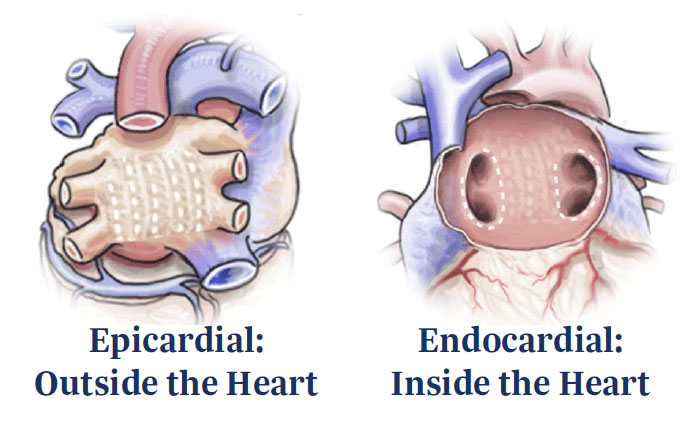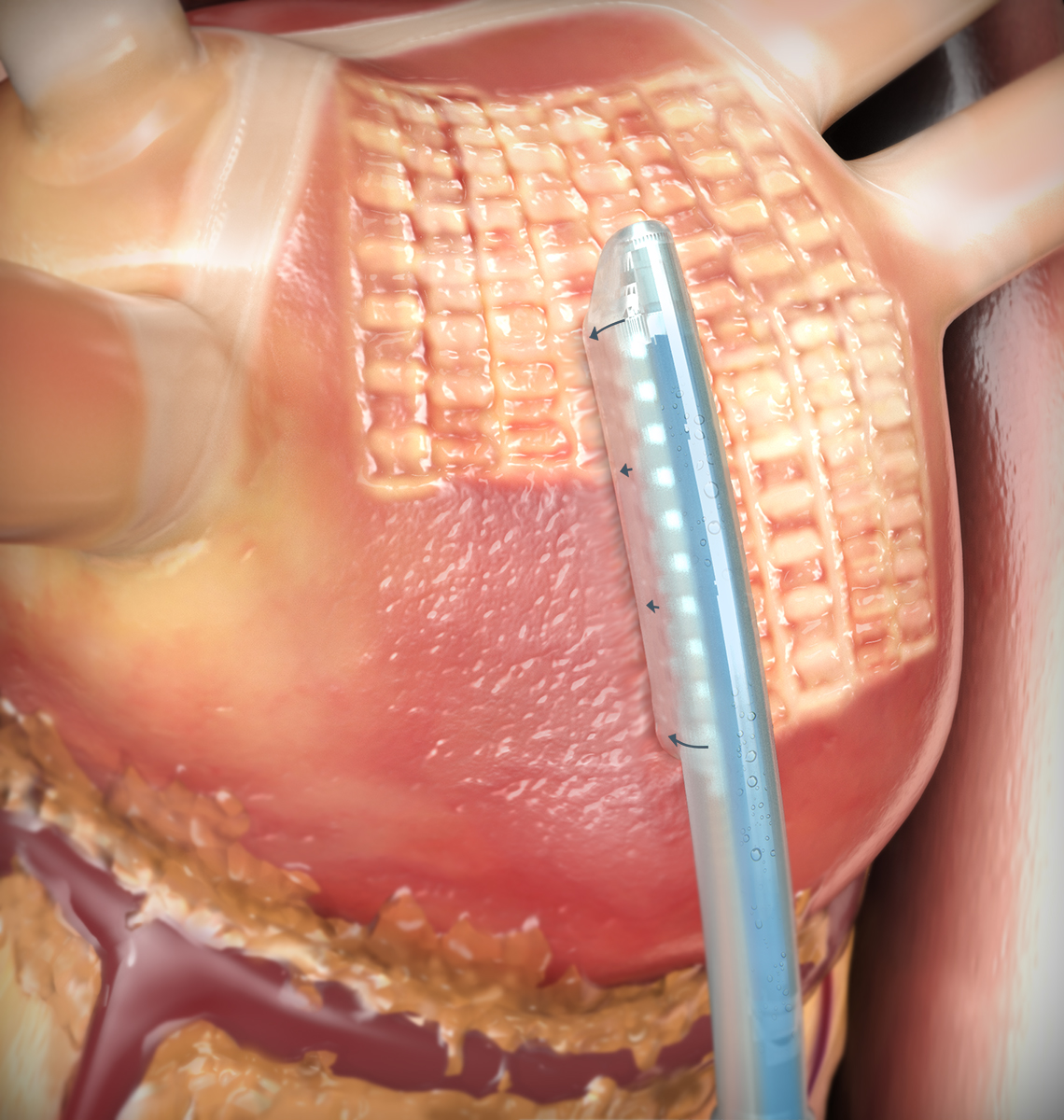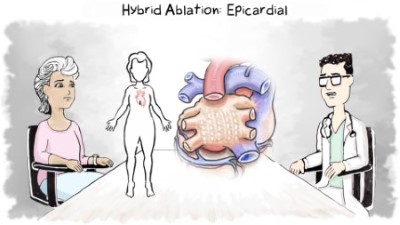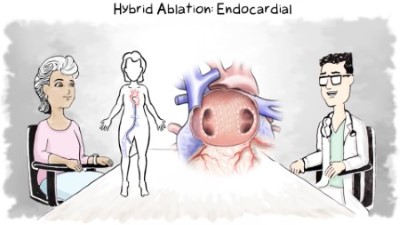Minimally Invasive Ablation to Treat Atrial Fibrillation
Two Types of Minimally Invasive Cardiac Ablation for Atrial Fibrillation
Ablation creates lesions on targeted areas inside (endocardial) or outside (epicardial) the heart. A lesion is a barrier that prevents the heart tissue from carrying erratic electrical signals that cause atrial fibrillation in the heart.
There are different types of targeted cardiac ablation:
- Endocardial ablation: Treating the inside of the heart
- Hybrid AF Therapy ablation: A combination of endocardial radiofrequency and epicardial ablation that treats both the inside and outside of the heart
A catheter is used for all types of ablation. A catheter is a long, thin, flexible tube that creates lesions. There are 2 ways that a doctor creates these lesions:
- Heat therapy, called radiofrequency (RF) ablation
- Cold therapy, called cryoablation
What Is Endocardial RF Ablation?
Endocardial RF ablation is also called catheter ablation. This type of ablation creates a lesion on the inside of the heart. However, endocardial AF ablation may not work as well for people in the more advanced stages of atrial fibrillation.1
A heart with more advanced atrial fibrillation often has more complicated erratic electrical signals. In such cases the heart may need more therapy since it has suffered more damage:
- Stretching of the posterior wall or back wall of the heart
- Stiffening of the heart muscle as it pumps out of rhythm
- Scarring of the heart that can lead to even more erratic electrical signals
The erratic electrical signals that cause atrial fibrillation often begin at certain trigger points in the heart, such as:
- The base of the pulmonary veins, which carry blood into the atrium
- The posterior wall, or back of the heart wall
- The left atrial appendage
Endocardial RF ablation often targets the trigger points at the pulmonary veins to treat atrial fibrillation.
What Is Hybrid AF Therapy and Ablation?
Hybrid AF Therapy is called hybrid because it combines both epicardial (outside the heart) ablation and endocardial (inside the heart) RF ablation to treat atrial fibrillation.
By combining epicardial and endocardial RF ablation, Hybrid AF Therapy is able to target at least 2 key trigger areas for atrial fibrillation.
- The posterior of the heart is treated with epicardial (outside the heart) ablation.
- The pulmonary veins are treated with endocardial (inside the heart) RF ablation.
It can be difficult to penetrate all the way through heart tissue (transmural) when treating from just one side of the heart. That’s why Hybrid AF Therapy—which treats both the inside and outside of the heart—may be more effective in stopping atrial fibrillation.2
In fact, a recent landmark clinical trial showed that Hybrid AF Therapy was more effective than endocardial RF ablation alone when treating long-standing persistent atrial fibrillation.2
When Hybrid AF Therapy effectively stops atrial fibrillation, it can:3
- Reverse the stretching of the left atrium
- Improve heart function overall
- Improve your symptoms
- Reduce the number of heart medications you need
What Is the Epicardial Ablation Portion of Hybrid AF Therapy?
Epicardial ablation creates a series of lesions on the outside of the heart. The lesions are usually put on the back or posterior wall of the left atrium.
 Remember that the left atrial appendage (LAA) is one of the areas of the heart where atrial fibrillation often begins. The LAA is a small, finger-like piece of tissue in the left atrium. During some Hybrid AF epicardial ablations, the entrance to the LAA may be closed. This prevents blood from moving between the LAA and the left atrium. See the areas of the heart where atrial fibrillation begins.
Remember that the left atrial appendage (LAA) is one of the areas of the heart where atrial fibrillation often begins. The LAA is a small, finger-like piece of tissue in the left atrium. During some Hybrid AF epicardial ablations, the entrance to the LAA may be closed. This prevents blood from moving between the LAA and the left atrium. See the areas of the heart where atrial fibrillation begins.
Epicardial ablation is a closed chest procedure, unlike surgical ablation which is done during open-heart surgery. Hybrid AF Therapy requires only a small incision in your chest called a subxiphoid incision.1
What Happens in a Hybrid AF Therapy Procedure?
Part 1 of the hybrid procedure is epicardial:
- The doctor makes a small incision in the chest called a subxiphoid incision.
- Once the doctor has access to the heart, lesions are placed across the posterior wall of the left side of the heart.
- These epicardial lesions overlap, creating a barrier to stop the erratic electrical signals that cause atrial fibrillation.
- Epicardial lesions target areas of the heart that cannot be reached from the inside of the heart.
Part 2 of the hybrid procedure is endocardia RF ablation:
- A second doctor makes a small incision in the femoral vein, at the top of the thigh. This allows access to your heart through the vein.
- The doctor looks at an electrical map of your heart. It can show any remaining abnormal electrical signals after your first procedure.
- The doctor then creates lesions at the pulmonary veins and any areas that still have abnormal electrical activity.
- Endocardial RF lesions treat areas of the heart that are difficult to reach epicardially.
Once these ablations are complete, the doctor verifies that both procedures have been successful.
What to Expect After Your Hybrid AF Therapy
The hospital stay will be typically 2-3 days. Your doctor will give you instructions for your recovery.
You will be given a patient card with important information about your procedures, medicines, and whom to call after you leave the hospital. Keep this in your wallet or purse.
Your health care team will let you know when you can return to your daily activities.



 Remember that the left atrial appendage (LAA) is one of the areas of the heart where atrial fibrillation often begins. The LAA is a small, finger-like piece of tissue in the left atrium. During some Hybrid AF epicardial ablations, the entrance to the LAA may be closed. This prevents blood from moving between the LAA and the left atrium. See the areas of the heart where atrial fibrillation begins.
Remember that the left atrial appendage (LAA) is one of the areas of the heart where atrial fibrillation often begins. The LAA is a small, finger-like piece of tissue in the left atrium. During some Hybrid AF epicardial ablations, the entrance to the LAA may be closed. This prevents blood from moving between the LAA and the left atrium. See the areas of the heart where atrial fibrillation begins.